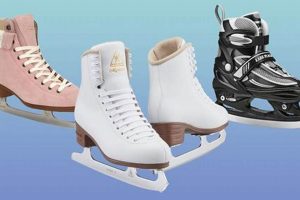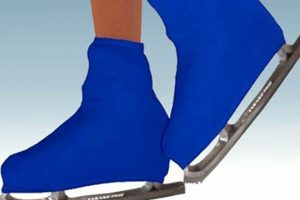Ice thickness is a critical factor in determining its safety for recreational activities. The structural integrity of frozen water dictates its ability to support weight, and adequate depth is paramount to prevent accidents. The degree of solidity needed increases with the load applied to the surface. For example, a single skater requires less depth than a group of people or a vehicle.
Ensuring sufficient depth reduces the risk of falling through, which can lead to hypothermia or drowning. Checking ice conditions has historically been done by experienced individuals using tools and visual inspection. Accurate evaluation prevents injuries and allows for safe enjoyment of winter sports. The ability to assess the solidity of the ice ensures personal safety and the safety of others.
Therefore, understanding the guidelines for safe ice depth is essential for anyone planning to participate in winter activities on frozen bodies of water. This article will delve into the specific depths required, methods for assessment, and other safety considerations.
Ice Thickness Safety Tips
Adhering to established guidelines regarding frozen water depth is crucial for ensuring safety during winter activities. These tips provide essential information for assessing ice conditions and minimizing risks.
Tip 1: Minimum Depth Requirement: Observe the recommended depth of at least four inches for skating. This depth typically supports the weight of a single individual, but it is still essential to exercise caution.
Tip 2: Consistent Thickness Verification: Measure the depth in multiple locations across the ice surface. Variations in water currents and temperature can lead to inconsistent solidity in different areas.
Tip 3: Avoid Areas with Obstructions: Stay clear of sections containing submerged trees, docks, or vegetation. These obstructions can weaken the ice and create hazardous conditions.
Tip 4: Monitor Weather Conditions: Changes in temperature and precipitation can significantly affect the solidity. Be aware of recent thaws or heavy snowfall, which can compromise its structural integrity.
Tip 5: Visual Inspection for Weak Spots: Look for cracks, discoloration, or pooling water on the surface. These signs indicate potential weaknesses and should be avoided.
Tip 6: Utilize Ice Testing Tools: Employ an ice auger or spud to accurately measure the depth. These tools provide a reliable method for assessing its condition and ensure precision.
Tip 7: Never Skate Alone: Always engage in winter activities with a companion. In case of an emergency, having someone present can provide assistance and call for help.
Following these recommendations drastically reduces the chances of accidents and contributes to a safer experience. Understanding and applying these guidelines is imperative for anyone venturing onto frozen bodies of water.
By prioritizing safety and remaining vigilant, individuals can enjoy winter activities while minimizing potential hazards. The following sections will discuss additional considerations for maximizing safety on the ice.
1. Minimum Depth
Minimum depth represents the baseline thickness requirement for ice to support the weight of an individual or group safely. It is a foundational element in determining whether frozen water is suitable for recreational activities such as skating. Understanding the minimum depth needed is vital for preventing accidents and ensuring participant well-being.
- Load Capacity Threshold
The load capacity threshold defines the amount of weight that a certain depth of frozen water can bear before failing. For example, while four inches might suffice for a lone skater, a group of people requires a significantly greater depth to distribute the collective weight. Exceeding the load capacity increases the risk of breakage. In practical terms, a family skating together demands a depth of perhaps seven or more inches.
- Ice Type Influence
The type of ice impacts the minimum depth required. Clear, blue ice is typically stronger than cloudy, white ice, which often contains air pockets and impurities. Impurities weaken the frozen structure. Consequently, cloudy ice necessitates a greater depth to achieve the same level of safety. For example, if clear ice is four inches, cloudy ice may require five or six to support the same weight.
- Dynamic Load Considerations
Dynamic loads, or sudden impacts or movements, place greater stress on the surface than static weight. Skating involves dynamic loads as individuals move and jump, increasing the force on the surface. This requires deeper measurements of the ice. A sudden stop or fall can exert considerable pressure, and a slightly shallower than recommended section might fracture under this stress.
- Environmental Factor Variability
Environmental conditions, such as temperature fluctuations and water currents, influence the consistency of depth. Thawing and refreezing cycles weaken the frozen structure, making it less reliable. Areas with faster currents often have thinner ice due to constant water movement hindering formation. Monitoring these environmental factors is essential for validating that the minimum depth is consistently maintained across the entire area.
The preceding facets illustrate that minimum depth is not a static value. It is a variable parameter affected by numerous intertwined factors. Successfully calculating it requires a nuanced understanding of these elements and consistent assessment of conditions. Overestimating the ability of frozen water leads to dangerous consequences. Prioritizing safety should always be the guiding principle when engaging in winter activities.
2. Ice Quality
Ice quality is a critical determinant of safe load-bearing capacity. It interacts directly with the necessary depth required for activities such as skating. Superior ice offers a greater strength-to-thickness ratio, whereas compromised ice necessitates increased depth to compensate for structural deficiencies. Factors such as clarity, homogeneity, and the presence of air pockets significantly influence its ability to support weight. For instance, black ice, which is dense and formed from slowly freezing water, possesses a higher load-bearing capacity compared to white or slushy ice of the same depth.
Variations in freezing and thawing cycles, snowfall, and underlying water currents all affect ice integrity. Repeated freeze-thaw cycles introduce microscopic fractures, reducing its overall strength. Snowfall acts as an insulator, slowing the freezing process and potentially creating softer, less stable layers. These environmental factors dictate both the depth and overall integrity and safety for skating. Areas with known spring activity must be approached with caution, as the ground water is warmer than the surface water. This can cause thin areas of ice, even if the surface appears frozen.
Therefore, any evaluation of ice safety must account for ice quality in conjunction with its depth. Simply meeting a minimum depth requirement is insufficient if its integrity is compromised. Proper assessment involves visual inspection for cracks, discoloration, and the presence of air pockets, as well as understanding recent weather patterns and local environmental conditions. This holistic approach allows for a more accurate assessment of the combined influence of its condition and depth, ultimately contributing to a safer experience.
3. Weight Load
Weight load is a primary factor in determining the minimum ice thickness necessary for safe recreational activities. The ability of ice to support a given weight is directly proportional to its thickness and inversely proportional to the distribution of the load.
- Static vs. Dynamic Load
Static weight refers to a constant, stationary force applied to the ice surface, such as a person standing still. Dynamic weight includes forces generated by movement, such as skating or running. Dynamic loads exert significantly greater stress on the ice compared to static loads of equivalent mass. For example, a person jumping exerts a force many times their static weight, necessitating a thicker ice sheet for safety.
- Distributed vs. Concentrated Load
The manner in which weight is distributed across the surface significantly affects its bearing capacity. A distributed load, such as a group of people spaced apart, exerts less stress per unit area compared to a concentrated load, such as a vehicle. Concentrated loads require substantially thicker ice to prevent localized fracturing. This distinction emphasizes the need to consider the nature of weight distribution when assessing ice safety.
- Impact of Ice Quality
The quality of the ice modulates its capacity to withstand weight. Clear, dense ice can support a greater load than cloudy, porous ice of the same thickness. Air pockets and impurities weaken the structure, reducing its load-bearing capacity. Therefore, thickness alone is an insufficient criterion; the type and quality must also be factored into safety assessments.
- Safety Margin Considerations
A safety margin is a crucial buffer to account for unforeseen variables, such as undetected ice imperfections or unexpected increases in weight. The implementation of a conservative safety factor is paramount. While four inches may theoretically support a single skater, increasing this to five or six inches provides a degree of protection against potential miscalculations or localized weaknesses.
The interrelationship between these aspects demonstrates that determining adequate frozen water thickness is not a simple measurement. It requires a nuanced understanding of load characteristics, ice integrity, and a commitment to conservative safety practices. Failure to account for these nuances can lead to hazardous miscalculations and preventable accidents.
4. Weather conditions
Weather conditions exert a profound influence on ice formation and its subsequent suitability for recreational activities. Temperature fluctuations, precipitation, and solar radiation directly affect both the rate of ice formation and its structural integrity. These factors necessitate careful consideration when evaluating the safety of ice thickness.
- Temperature Fluctuation Impact
Fluctuating temperatures, particularly cycles of freezing and thawing, significantly compromise ice integrity. Repeated thawing weakens the ice structure, creating internal fractures and reducing its load-bearing capacity. Such conditions necessitate a greater thickness than would be required under consistently sub-freezing temperatures. For instance, ice that has undergone several thaw-freeze cycles may require twice the thickness of newly formed ice to support the same weight.
- Snowfall Insulation Effect
Snowfall acts as an insulator, hindering the freezing process and potentially creating pockets of unfrozen water beneath the surface. This insulating effect can lead to variations in thickness across a body of water, making it crucial to assess multiple points before deeming it safe. A heavy snowfall followed by a brief warming period can create a deceptively thin layer of ice covered by a seemingly solid snowpack, posing a significant hazard.
- Solar Radiation Influence
Solar radiation, even in sub-freezing temperatures, can weaken ice, particularly if the ice surface is dark or covered with debris. The absorption of solar energy warms the ice, leading to melting and the formation of weak spots. South-facing ice surfaces are especially vulnerable, requiring greater thickness to compensate for the weakening effect of solar radiation.
- Precipitation and Runoff Effects
Rainfall and snowmelt introduce warm water into the system, accelerating the melting process and potentially creating channels and weak spots within the ice sheet. Runoff from nearby land can also carry contaminants that further degrade ice quality. Areas near inlets and outlets are particularly susceptible to these effects, necessitating increased ice thickness for safe usage.
Considering these multifaceted effects of weather conditions is critical when determining the required ice thickness for safe skating. Relying solely on a single measurement without accounting for these environmental variables can lead to inaccurate assessments and increased risk. A comprehensive understanding of prevailing and recent weather patterns, coupled with thorough on-site inspection, is essential for ensuring ice safety.
5. Monitoring Frequency
Monitoring frequency, in the context of ice safety, directly impacts the reliability of any assessment regarding minimum thickness. The dynamic nature of ice, influenced by fluctuating temperatures, precipitation, and solar radiation, necessitates regular reassessment. Infrequent checks can lead to inaccurate evaluations, as conditions can change rapidly, rendering previous measurements obsolete. The relationship is causal: insufficient monitoring increases the risk of encountering unexpectedly thin or unstable areas.
Consider a scenario where ice is deemed safe based on a thickness measurement taken during a period of consistently sub-freezing temperatures. If a subsequent warm spell occurs, even for a short duration, the surface may begin to thaw, reducing its structural integrity without any outward visible signs. Without regular reassessment following the thaw, individuals relying on the initial measurement could unknowingly venture onto weakened ice. Daily, or even more frequent, checks are crucial during periods of variable weather to ensure that the thickness remains adequate and consistent with the prevailing conditions. The monitoring should include multiple points across the area to account for localized variations.
In summary, consistent monitoring provides a necessary layer of safety beyond the initial measurement. Weather and environmental variables can create changes in ice condition even in short periods of time. Consistent monitoring provides accurate assessment which reduces the possibility of dangerous miscalculations of solidity and preventing accidents. Routine evaluations of ice conditions ensures that recreational activities occur with minimized risk.
6. Safety equipment
The utilization of safety equipment acts as a critical supplementary measure when engaging in activities on frozen surfaces. While ensuring adequate ice thickness is paramount, unforeseen circumstances necessitate the availability and proper use of specialized gear. This equipment serves as a safeguard against potential hazards, mitigating the risks associated with unexpected shifts in conditions.
- Ice Awls/Picks
Ice awls or picks are handheld tools designed to provide traction on ice, enabling self-rescue in the event of a fall through. These devices, typically worn around the neck or easily accessible, allow individuals to grip the surface and pull themselves out of the water. Even with seemingly sufficient solidity, localized weaknesses or unforeseen cracks can lead to a fall; ice picks are the means of self-extrication. They become even more critical when skating on bodies of water where the solidity is questionable, as they provide a last resort for survival.
- Personal Flotation Device (PFD)
A personal flotation device, or PFD, provides buoyancy in water, increasing the chances of survival in a fall-through situation. Even experienced skaters can become disoriented or incapacitated in cold water, making a PFD a critical piece of safety gear. These devices keep the wearer afloat, allowing them to conserve energy and await rescue. The value of a PFD becomes acutely apparent on bodies of water with variable solidity, where the risk of unexpected immersion is higher.
- Throw Rope
A throw rope is a length of rope designed for throwing to someone who has fallen through the ice. This allows a rescuer to assist the individual from a safe distance, minimizing the risk of further accidents. A throw rope is beneficial, particularly when combined with other safety equipment, is most useful when there are multiple skaters. A throw rope could also be used by a skater to attempt to reach shore if the skater cannot pull themselves out of the water.
- Ice Auger or Spud
While not directly used for rescue, an ice auger or spud is essential for proactively assessing conditions. These tools allow for the boring of holes to measure solidity at various points. Utilizing this equipment helps to confirm if the minimal measurement requirements are met and to identify areas with potentially hazardous variations in solidity. By providing accurate measurements, these tools contribute to informed decision-making, minimizing the likelihood of encountering unsafe conditions.
These safety measures are not substitutes for assessing the measurement, they provide an additional layer of protection. By complementing solidity assessments with appropriate safety measures, individuals minimize potential risks and contribute to a safer experience. The combination of proactive measurement and responsive measures represents a balanced approach to ice safety.
Frequently Asked Questions
This section addresses common inquiries regarding determining adequate solidity for safe skating, providing essential information to minimize risks associated with winter activities on frozen bodies of water.
Question 1: What is the minimum ice thickness generally considered safe for skating?
A minimum thickness of four inches of clear, solid frozen water is typically considered safe for a single skater. However, this measurement is a baseline and should be supplemented by additional assessments of quality and prevailing conditions.
Question 2: How does ice quality affect safety, even if the minimum thickness requirement is met?
Ice quality significantly impacts its load-bearing capacity. Clear, blue, dense ice is stronger than cloudy, white frozen water. If the ice is porous, contains air pockets, or exhibits signs of thawing and refreezing, a greater thickness is necessary to ensure safety.
Question 3: Does the required ice thickness change based on the number of people skating?
Yes. As the weight load increases, so does the required thickness. While four inches may suffice for a single individual, a group of people requires significantly thicker ice to distribute the collective weight safely. Consult established guidelines for specific recommendations based on group size.
Question 4: How do weather conditions influence ice safety, and how often should conditions be monitored?
Fluctuating temperatures, snowfall, and solar radiation all affect the integrity. Thawing and refreezing cycles weaken the structure. Snowfall insulates the surface, potentially concealing thinner areas. Solar radiation can melt the surface, creating weak spots. Conditions should be monitored frequently, especially during periods of variable weather.
Question 5: What safety equipment is recommended for skating, even if the ice appears sufficiently thick?
Ice awls or picks, a personal flotation device (PFD), and a throw rope are recommended safety equipment. Ice awls enable self-rescue in the event of a fall-through. A PFD provides buoyancy in cold water. A throw rope allows rescuers to assist from a safe distance.
Question 6: Can ice ever be considered completely risk-free for skating?
No. There is always an inherent risk associated with activities on frozen bodies of water. Even with careful assessment and adherence to safety guidelines, unforeseen variables can arise. Exercising caution and vigilance is paramount.
These answers underscore the importance of a comprehensive approach to ice safety, encompassing thickness measurements, quality assessments, weather monitoring, and the use of appropriate safety equipment.
The subsequent section will address how to check ice thickness properly.
Conclusion
Determining how thick does ice have to be to skate on involves assessing multiple interconnected factors beyond a single measurement. Structural integrity, weight load, weather patterns, and vigilant monitoring each contributes to a comprehensive safety evaluation. Relying solely on minimal solidity standards without accounting for these variables introduces significant risk.
Prioritizing informed decision-making, continuous assessment, and adherence to established safety protocols reduces the potential for accidents. Recognizing the inherent dangers associated with activities on frozen bodies of water and consistently applying conservative safety margins ensures a more secure recreational experience. The responsibility for safe practices rests ultimately with each individual.







